Service identity in hybrid environments
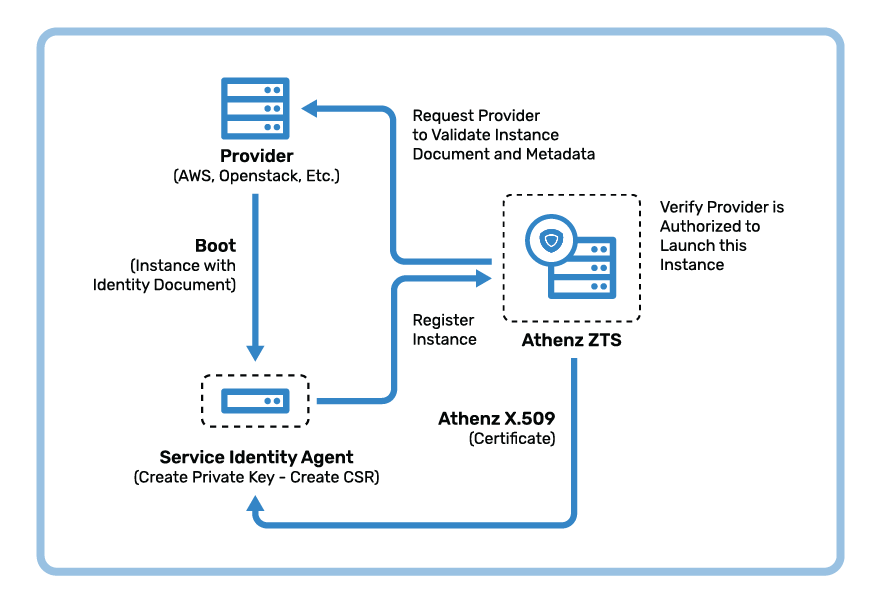
Introduction
Athenz uses a callback-based verification model to provide identity to dynamic workloads running in hybrid environments.
Challenges
In today’s dynamic infrastructure, workloads / services can be launched in various environments like on-premise, cloud and hybrid using providers like Openstack, Kubernetes and Amazon Web Services. The challenge is to be able to provide an identity to those in a secure way irrespective of the environment or provider.
Solution
Athenz provides a clear contract for service providers to launch tenant service identities in an authorized way through a callback-based verification model. The following steps describe the workflow:
Benefit
By having Athenz as an identity provider in a hybrid environment solves the most crucial problem of service identity in “zero trust” and provides a consistent authentication mechanism. Also with this model, the private key which is the most important one is actually generated on the instance itself and never leaves it. Additionally each instance/workload gets a unique certificate. Using the identity certificate the service optionally can fetch standards based mtls bound access tokens from Athenz Token Service and use them for authorization support.
Result
Yahoo was able to obtain a consistent service identity for thousands of services deployed in various environments like Openstack virtual machines and bare metal hosts, Kubernetes, AWS computes, containers and serverless functions.
Athenz Auth Webhook
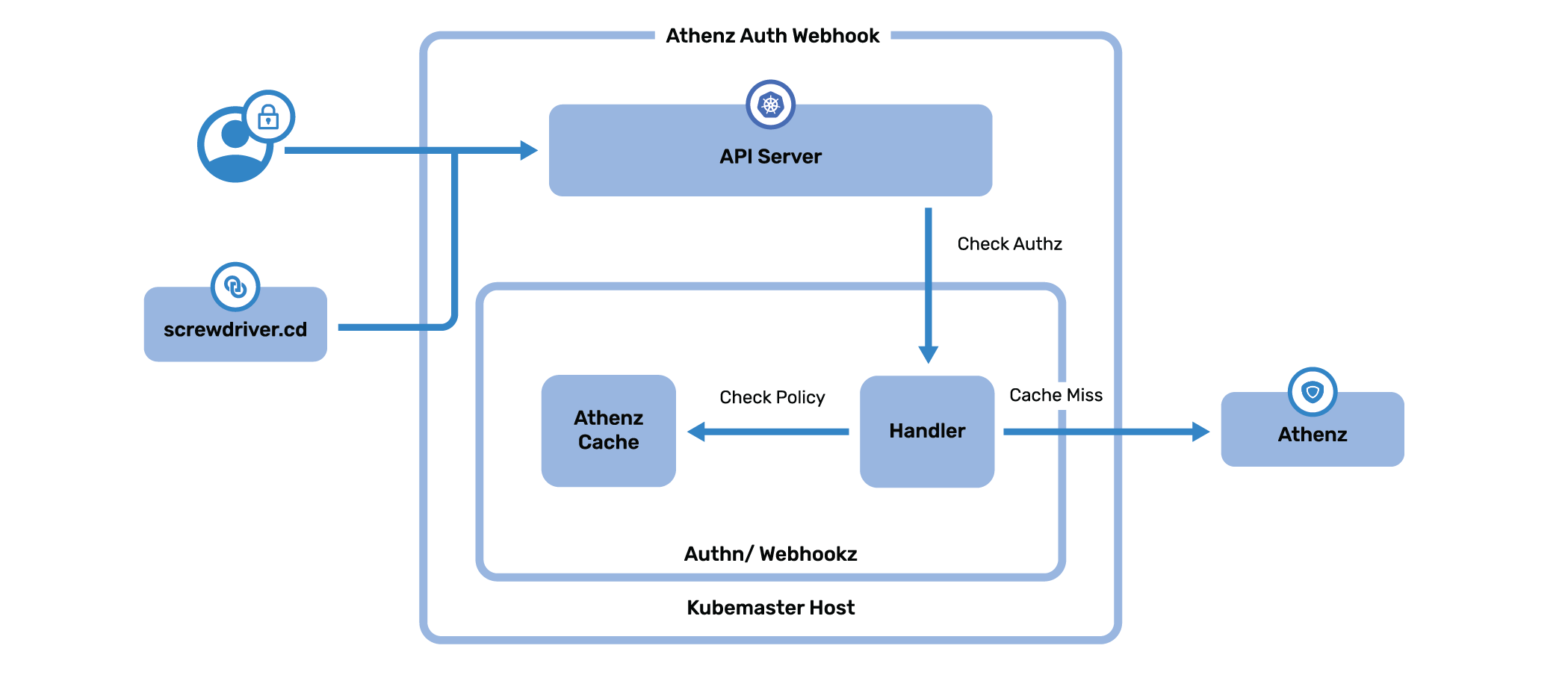
Introduction
The Athenz webhook is an API for the Kubernetes authentication and authorization webhook that integrates with Athenz for access checks. It allows flexible resource mapping from Kubernetes resources to Athenz. Access checks within a Kubernetes cluster include any kubectl commands the users may run or direct access through APIs. The webhook also has caching capabilities built in to directly make access decisions without any network hops.
Challenges
There are multiple challenges while attempting to use Kubernetes native Role-based access control (RBAC) in a larger organization with many clusters which are multi-tenant. The Kubernetes Role-based access control (RBAC) becomes tough to manage when the access control rules need to be defined across many different clusters the applications are deploying to with many different users accessing them throughout many different independent teams. These application owners need to have full autonomy to be able to change rules at any moment without going through a complicated pipeline or process.
Solution
Athenz can directly be hooked into the access control checks in the kubernetes authentication and authorization flow by introducing the athenz webhook which will reach out to Athenz to make access decisions. This webhook is invoked any time users are running the kubernetes kubectl commands or accessing directly through any APIs.
Benefit
The use of Athenz has many benefits across an organization, primarily it is a single source of truth for Role-based access control (RBAC) across all kubernetes clusters. It allows users to directly define Kubernetes access control to resources managed in their own namespaces. This allows namespace admins of development teams to be able to add and remove access control rules to the athenz roles and policies which will have immediate effect across all clusters.
Result
Integrating Athenz into the Kubernetes ecosystem allows teams to be more autonomous in the management of their access controls. The platform team along with the individual application teams can have full control over their own Role-based access control (RBAC) without relying on any specific pipelines and processes which rapidly speeds up development and deployment times. The platform team is also able to maintain the same set of access control rules across multiple Kubernetes clusters which speeds up platform level changes and new cluster creation.
For more details please check out the k8s-athenz-webhook project in Github.
Athenz Istio Auth Controller
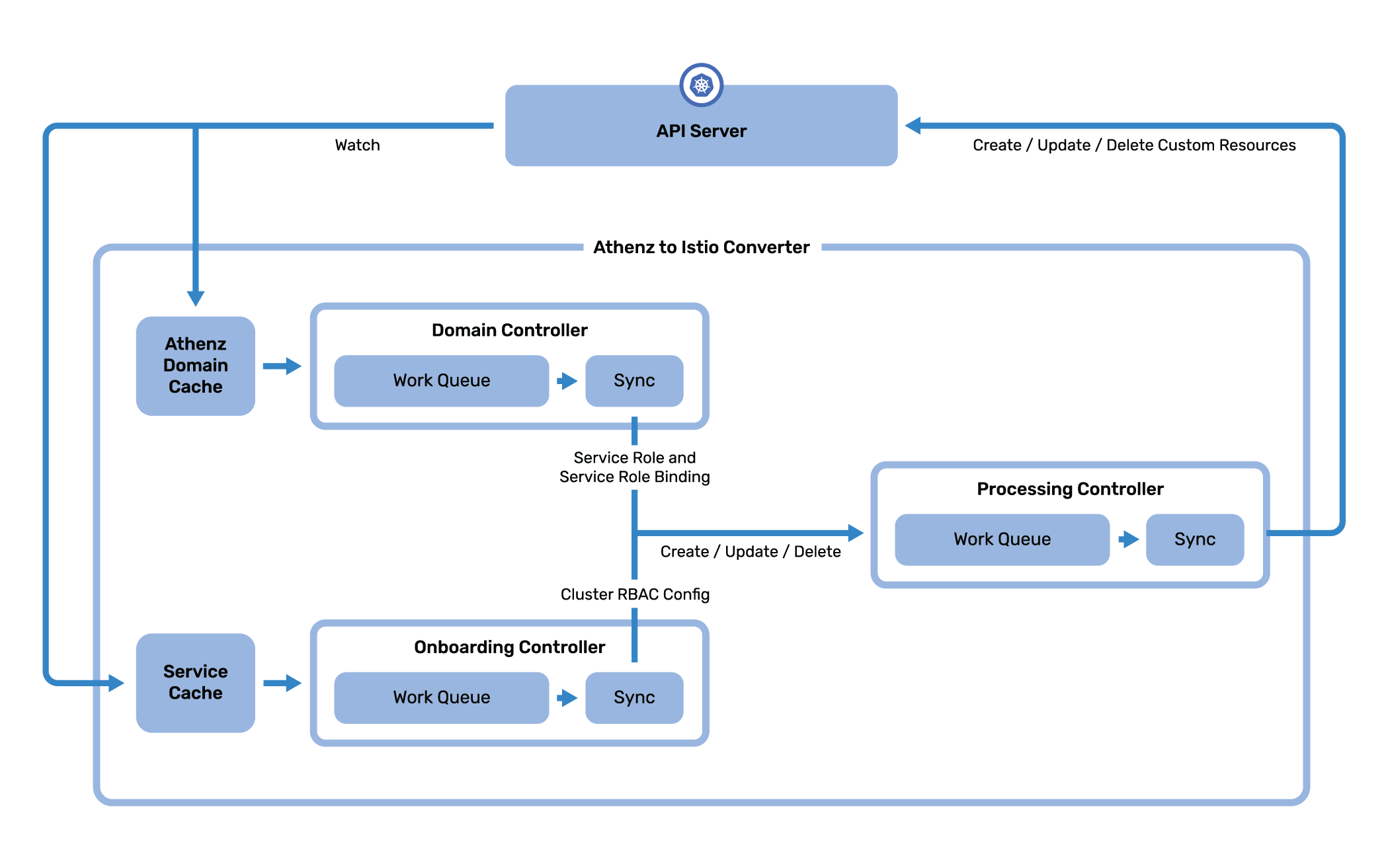
Introduction
The Athenz Istio Auth controller is responsible for the conversion of Athenz Role-based access control (RBAC) into Istio custom resources. This enables users to dynamically configure service to service authorization directly through Athenz.
Challenges
When the Istio service mesh was introduced into the organization, it brought along with it a lot of complexities in terms of user management as it is a technology with many different features and configurations. Due to this complex overhead, we as the platform team realized it was not a scalable solution for all application developers in the company to learn Istio for them to be able to define service to service authorization. These development teams would also need to be responsible for the management of Istio configurations and their corresponding deployments. All of these issues make onboarding authorization much tougher for individual developers.
Solution
Athenz is directly used as an Role-based access control (RBAC) provider in order to define service to service authorization rules. Application developers are able to go into the Athenz UI and define which services are allowed to communicate with each other. These access rules are then picked up by this athenz Istio auth controller which will go ahead and convert them to the corresponding Istio Role-based access control (RBAC) rules which will then be propagated to the services to enforce authorization.
Benefit
The primary benefit of utilizing Athenz is the simplicity of the interface. The UI allows users to easily define access control rules simply without complex configuration. Since an organization can use Athenz for a variety of different use cases for identity and access management, developers in the organization only need to be familiar with one technology to define access rules across multiple technologies and stacks. The service to service authorization is just one such use case which Athenz makes possible.
Result
Utilizing Athenz as the interface to define service to service authorization greatly speeds up development times for application owners and makes the feature self service which allows for full autonomy. The UI allows users to quickly turn authorization rules on and off as opposed to going through some sort of deployment pipeline which needs to deploy configuration into Kubernetes clusters. Due to our controller being able to pick these rules up quickly, the changes are almost immediately reflected on the system. It also means that developers are not required to learn the complex ecosystem which is Istio to define these access rules but can define them through an interface they are familiar with, Athenz, in order to get the benefits.
For more details please check out the k8s-athenz-istio-auth project in Github.
Athenz Service Identity
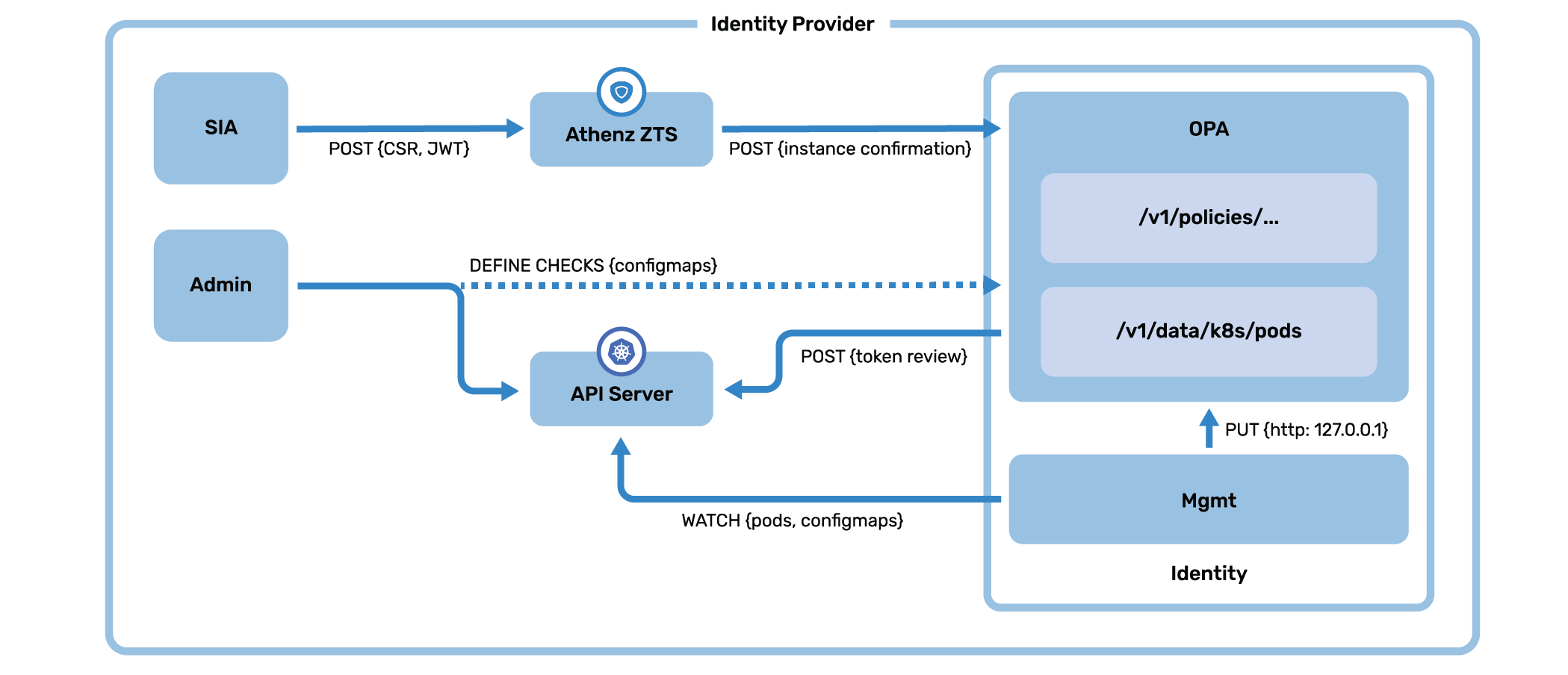
Introduction
Every container launched in Kubernetes needs unique identity and secure credentials to authenticate with other dependent systems. The kubernetes service account token can be used to exchange credentials with external auth systems to provide a much wider globally scoped credentials such as Athenz service identity certificates.
Challenges
Every application that needs to interact with an internal/external service needs to have an identity for its authentication and authorization. Such identities are usually associated with the application instance rather than the node on which the application instance is running. Hence, the container platform needs to provide an API for workloads to obtain and refresh such credentials.
Solution
A Service Identity Agent (SIA) container on the pod is responsible for obtaining and refreshing Athenz service certificates. The SIA container creates a CSR attached with the kubernetes bound service account JWT and makes an Athenz service identity certificate request to ZTS. ZTS forwards the request to an in-cluster identity provider (Identityd) which validates the kubernetes JWT with the help of API server and authenticates the SIA request. On successful validation, ZTS issues a service identity certificate to the SIA which is shared with the application.
Benefit
The container platform provisions identities to applications with minimal or zero user effort at scale that can be used for intra-cluster service-to-service authentication. The private keys are short lived and rotated with every certificate refresh providing a secure identity framework.
Result
A secure identity provider mechanism for container workloads provisioning unique short lived credentials that can be universally used to authenticate and authorize with dependent systems is critical to any container platform and this solution provides the necessary building blocks to integrate Athenz Role-based access control (RBAC) with kubernetes workloads.
For more details please check out the k8s-athenz-identity project in Github.
MTLS bound access tokens
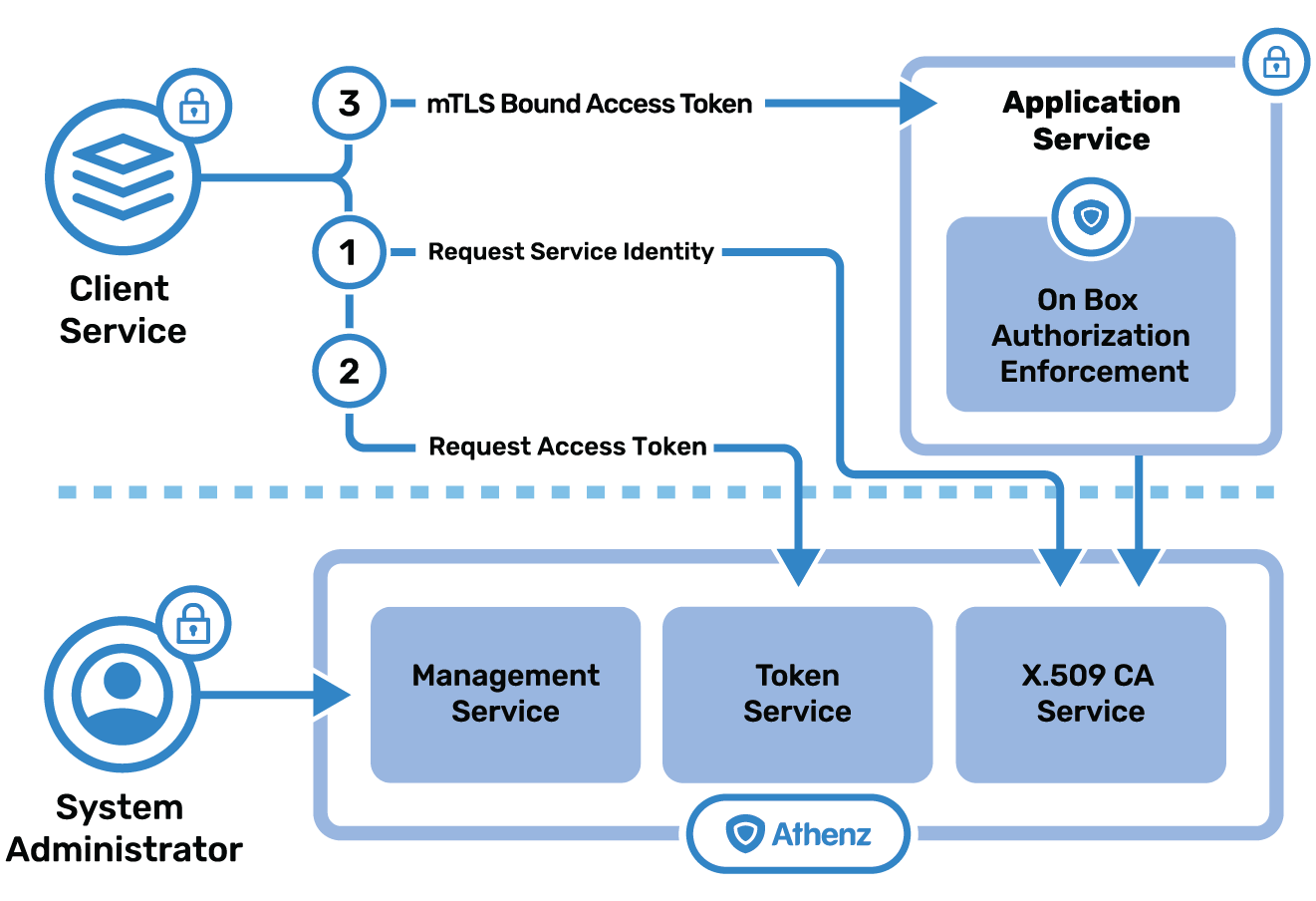
Introduction
Mutual authentication based on Transport Layer Security (TLS) X.509 certificates refers to both client and server authenticating each other by verifying the provided X.509 certificates such that both parties are assured of the others' service identity. Access tokens are the security credentials that identify the privileges which the calling service has to access resources owned by a different service. Athenz provides centralized as well as decentralized authorization capabilities and client libraries to facilitate it.
Challenges
How to harden the security by enabling mutual TLS authentication between all the services, clients, and components and authorize action(s) the authenticated principal is trying to perform on your resources?
Solution
The expectation is that clients and services are authenticating using X.509 Service Identity Certificates issued by Athenz Certificate Authority (CA).
Before a client makes any https connection to process a request, it must be registered with an Athenz Service Provider to be issued a short-lived x.509 certificate that is automatically renewed. Whereas the server is configured to require Athenz Service Identity x.509 Certificates for any endpoint requiring authorization and is configured with Athenz CA certificates in its truststore.
The client using its Athenz issued X.509 identity certificate requests an authorization token from Athenz Token Service that issues mTLS bound OAuth2 access tokens (RFC8705: OAuth 2.0 Mutual-TLS Client Authentication and Certificate-Bound Access Tokens) the application services can use to authorize requests based on policies defined in the Athenz Management System after authentication based on x.509 identity certificates. Support for OAuth2 access tokens is based on Client Credentials authentication workflow as defined in RFC6749: The OAuth 2.0 Authorization Framework.
To prevent the replay attacks, Athenz Token Service adds a claim in the access token with the SHA-256 hash of the x.509 identity certificate used to request the access token. That way the receiving service can verify the hash in access token with the incoming certificate. By ensuring that services only trust Athenz CA, bad actors with identity obtained with the same Subject but from a different CA will not be accepted.
Benefit
With Athenz Service Provider support, each instance/workload gets a unique private key generated on the instance itself and a unique x.509 certificate that does not need to be propagated to other instances. The private key never leaves the instance thus reducing its exposure. Using those x.509 certificates to enforce mutual TLS authentication, all network traffic between services, clients, and components are encrypted in transit and the services have a complete knowledge and control of ingress and egress. By doing mTLS, only trusted clients are allowed to connect and all the bad actors are rejected. Using the mtls bound access tokens enables services to enforce fine-grained authorization to provide the least privileged access to their resources without the possibility of replay attacks.
Result
By using Athenz provided authorization mechanism, combined with mTLS bound access tokens, services can implement authorization with minimal code and configuration that would allow them to concentrate on delivering business value.
AWS temporary credentials for on-premise services
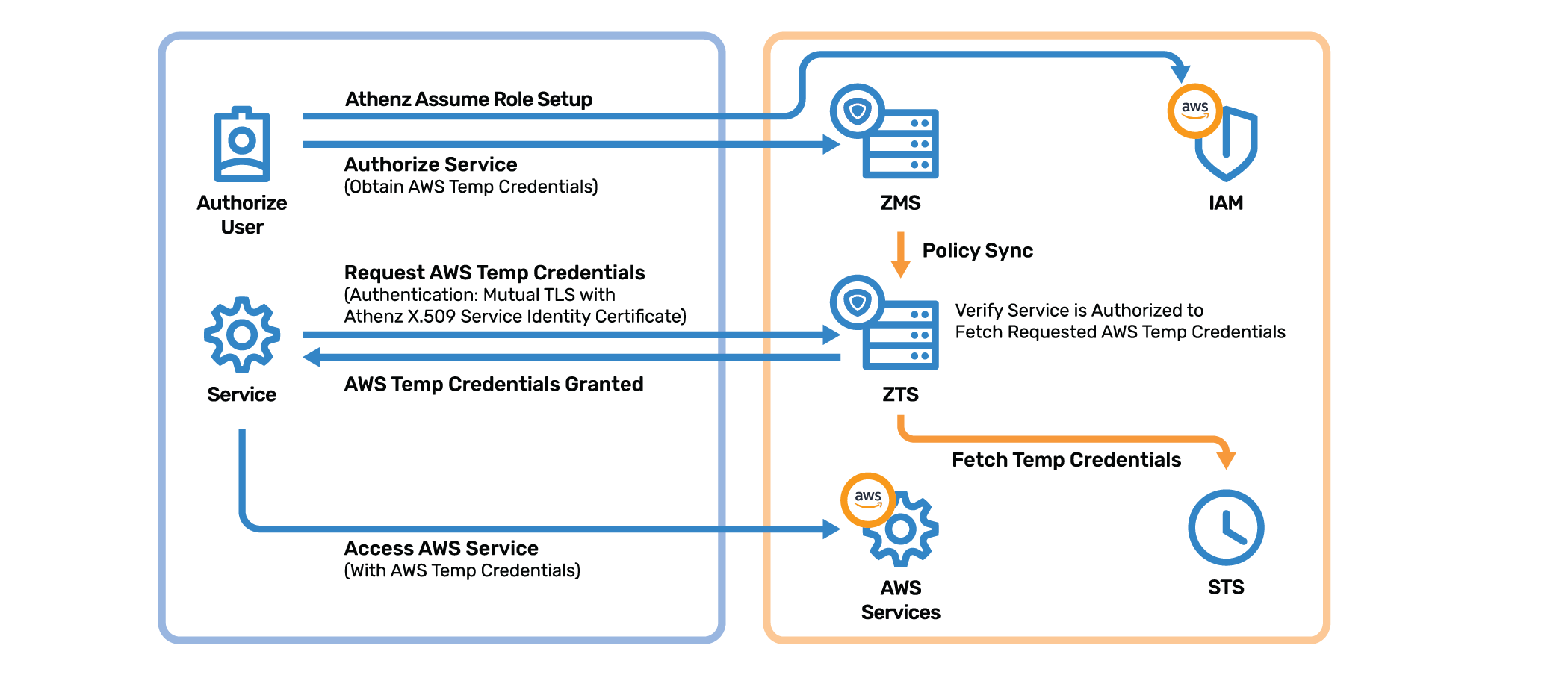
Introduction
AWS Temporary Credentials are issued by AWS Security Token Service (AWS STS) to authenticated users and control access to AWS resources. Athenz provides a capability to give the temporary credentials in a secure way to on-premise services so that it can use AWS resources without using static credentials.
Challenges
How to securely access AWS services from on-prem data centers without using static credentials defined in AWS Identity and Access Management?
Solution
If Athenz Token Service ( ZTS ) is deployed in AWS, it can bridge between AWS IAM roles/STS and Athenz Service Identities. As such any service that is running in an on-prem data center and needs to access AWS Services can first obtain AWS Temporary credentials from Athenz ZTS Service and then use those credentials with AWS SDK. When requesting AWS temporary credentials for a role, the account administrator sets up an AssumeRole policy that authorizes cross-account access to Athenz ZTS Service.
To request AWS temporary credentials, the domain administrator must first set their account id in their Athenz Domain configuration. It is assumed that the administrator has already created a role in AWS IAM that they would like to obtain temporary credentials for. The important part of the setup is the trust relationship for that role such that Athenz ZTS can assume that role. The role must be configured with the following trust relationship statement:
{
"Effect": "Allow",
"Principal": {
"AWS": "arn:aws:iam::<Athenz-ZTS-Service-Account-ID>:role/<Athenz-ZTS-Service-Identity>"
},
"Action": "sts:AssumeRole"
}
It is strongly recommended that the trust policy is configured to require an external ID to be provided. By including the external id condition in the AssumeRole policy, the account administrator secures its roles to be accessed by unauthorized principals through ZTS since AWS STS will reject any "assume role" requests unless the external id is specified as part of the request. Even though the external id is passed as part of the uri, the ZTS server automatically strips out and does not log the external id in its access log file.
Once the AWS setup has been completed, the domain administrator is ready to set up the authorization policies in Athenz Management Service. In ZMS, the administrator would create a role in their domain with any service identities that may request temporary credentials for the AWS role. Then, the administrator would create a policy authorizing the configured Athenz role members to assume the AWS role. When creating the policy the action must be `assume_aws_role`, and resource must be the IAM role name.
At this point any client that has been authorized to assume the configured IAM role in Athenz may use their service identity X.509 certificate, contact ZTS and request AWS temporary credentials which then it can use to access AWS services.
Benefit
This feature eliminates the need to manage AWS static credentials when accessing AWS services from on-prem services since those need to be invalidated and rotated when users having access to those credentials leave the company.
Result
Services deployed in on-premise data centers can still utilize AWS resources by using Athenz provided temporary credentials without compromising security.